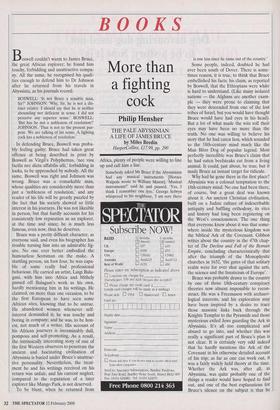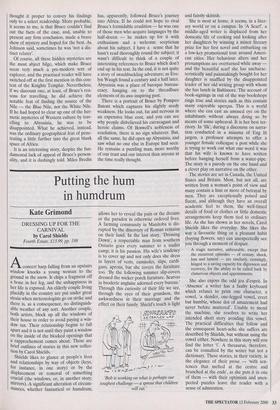BOOKS
More than a fighting cock
Philip Hensher
THE PALE ABYSSINIAN: A LIFE OF JAMES BRUCE by Miles Bredin HaiperCollins,177.99, pp. 290 Boswell couldn't warm to James Bruce, the great African explorer; he found him touchy, forbidding and unattractive compa- ny. All the same, he recognised his quali- ties enough to defend him to Dr Johnson after he returned from his travels in Abyssinia, as his journals record: BOSWELL: 'Is not Bruce a sensible man, Sir?' JOHNSON: 'Why, Sir, he is not a dis- tinct relater. I should say that he is neither abounding nor deficient in sense. I did not perceive any superior sense.' BOSWELL: `But has he not a nobleness of resolution?' JOHNSON. That is not to the present pur- pose. We are talking of his sense. A fighting cock has a nobleness of resolution.'
In defending Bruce, Boswell was proba- bly feeling guilty; Bruce had taken great offence at being described in print by Boswell as Virgil's Polyphemus, 'nee vim facilis nee dictu affabilis ulli,' forbidding in looks, to be approached by nobody. All the same, Boswell was right and Johnson was wrong. Bruce was a remarkable man, whose qualities are considerably more than just a 'nobleness of resolution,' and any reader of his life will be greatly puzzled by the fact that his society showed so little interest in his journeys. He was not likeable in person, but that hardly accounts for his consistently low reputation as an explorer, at the time and since; he is much less famous, even now, than he deserves.
Bruce was a pretty difficult character, as everyone said, and even his biographer has trouble turning him into an admirable fig- ure. No one ever better embodied the humourless Scotsman on the make. A startling person, six foot four, he was capa- ble of some really bad professional behaviour. He carried an artist, Luigi Balu- gani, with him into Africa and blithely passed off Balugani's work as his own, hardly mentioning him in his writings. He claimed, on more than one occasion, to be the first European to have seen some African sites, knowing that to be untrue. He abandoned women whenever self- interest demanded it; he was touchy and boring in company; and he was, to be hon- est, not much of a writer. His account of his African journeys is interminably dull, pompous and self-promoting. As a result, the intrinsically interesting story of one of the first Western observers to penetrate the ancient and fascinating civilisation of Abyssinia is buried under Bruce's unattrac- tive personality. Nevertheless, the treat- ment he and his writings received on his return was unfair, and his current neglect, compared to the reputation of a later explorer like Mungo Park, is not deserved.
To be blunt, when he returned from Africa, plenty of people were willing to line up and call him a liar.
Somebody asked Mr Bruce if the Abyssinians had any musical instruments [Horace Walpole wrote to William Mason]. 'Musical instruments?' said he and paused. 'Yes, I think I remember one lyre.' George Selwyn whispered to his neighbour, 'I am sure there is one less since he came out of the country.'
Some people, indeed, doubted he had ever been south of Dover. There is some- times reason, it is true, to think that Bruce embellished his facts; his claim, as reported by Boswell, that the Ethiopians were white is hard to understand. (Like many isolated nations — the Afghans are another exam- ple — they were prone to claiming that they were descended from one of the lost tribes of Israel, but you would have thought Bruce would have had eyes in his head). But a lot of what made the wits roll their eyes may have been no more than the truth. No one was willing to believe his story that he had eaten lion, which sounded to the 18th-century mind much like the Man Bites Dog of popular legend. Most perfectly incredible was Bruce's claim that he had eaten beefsteaks cut from a living animal. It could, just about, be true, but it made Bruce an instant target for ridicule.
Whey had he gone there in the first place? Abyssinia was a colossal temptation to the 18th-century mind. No one had been there, of course, but a great deal was known about it. An ancient Christian civilisation, built on a Judaic culture of indescribable antiquity and baffling orthodoxy, its rites and history had long been registering on the West's consciousness. The one thing that everyone knew about it was that some- where inside the mysterious kingdom was the biblical Ark of the Covenant, Gibbon writes about the country in the 47th chap- ter of The Decline and Fall of the Roman Empire, concluding characteristically that after the triumph of the Monophysite churches in 1632, 'the gates of that solitary realm were for ever shut against the arts, the science and the fanaticism of Europe'.
Bruce was probably drawn to the country by one of those 18th-century conspiracy theories now almost impossible to recon- struct. He was a Freemason with archaeo- logical interests, and his exploration may have been inspired by a desire to trace those masonic links back through the Knights Templar to the Pyramids and those mysterious exiled Jews guarding the Ark in Abyssinia. It's all too complicated and absurd to go into, and whether this was really a significant part of Bruce's plan is not clear. It is certainly very odd indeed that he hardly mentions the Ark of the Covenant in his otherwise detailed account of his trip; as far as one can work out, it was a fairly widely held theory at the time. Whether the Ark was, after all, in Abyssinia, was quite probably one of the things a reader would have hoped to find out, and one of the best explanations for Bruce's silence on the subject is that he thought it proper to convey his findings only to a select readership. More probable, it seems to me, is that Bruce couldn't find out the facts of the case, and, unable to present any firm conclusion, made a brave show of mystery and hoped for the best. As Johnson said, sometimes he was 'not a dis- tinct relater'.
Of course, all these hidden mysteries are the most abject bilge, which make Bruce seem very much a pre-modern sort of explorer, and the practised reader will have switched off at the first mention in this con- text of the Knights Templar. Nevertheless, if we discount one, at least, of Bruce's rea- sons for travelling, he did achieve the notable feat of finding the source of the Nile — the Blue Nile, not the White Nile. If he had hoped to clear up one of the her- metic mysteries of Western culture by trav- elling to Abyssinia, he was to be disappointed. What he achieved, instead, was the ordinary geographical feat of pene- trating a little further into the great blank space of Africa.
It is an interesting story, despite the fun- damental lack of appeal of Bruce's person- ality, and it is dashingly told. Miles Bredin has, apparently, followed Bruce's journey into Africa. If he could not hope to rival Bruce's formidable erudition — he was one of those men who acquire languages by the half-dozen — he makes up for it with enthusiasm and a welcome scepticism about his subject. I have a sense that he hasn't read thoroughly round the subject; it wasn't difficult to think of a couple of interesting references to Bruce which don't end up in his text. In the end, it is not quite a story of swashbuckling adventure; as Eve- lyn Waugh found a century and a half later, Abyssinia was a place of baroque bureau- cracy, hanging on to the threadbare elements of its awe-inspiring past. There is a portrait of Bruce by Pompeo Batoni which captures his slightly seedy weakness. He looks out, fat and nervous in an expensive blue coat, and you can see why people disbelieved his extravagant and heroic claims. Of Boswell's nobleness of resolution, there is no sign whatever. But, all the same, he did open up Abyssinia, and saw what no one else in Europe had seen. He remains a puzzling man, more worthy of our trust and our interest than anyone at the time really thought.



































































 Previous page
Previous page